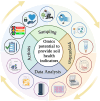Culturomics- and metagenomics-based insights into the soil microbiome preservation and application for sustainable agriculture
- PMID: 39526137
- PMCID: PMC11544545
- DOI: 10.3389/fmicb.2024.1473666
Culturomics- and metagenomics-based insights into the soil microbiome preservation and application for sustainable agriculture
Abstract
Soil health is crucial for global food production in the context of an ever-growing global population. Microbiomes, a combination of microorganisms and their activities, play a pivotal role by biodegrading contaminants, maintaining soil structure, controlling nutrients' cycles, and regulating the plant responses to biotic and abiotic stresses. Microbiome-based solutions along the soil-plant continuum, and their scaling up from laboratory experiments to field applications, hold promise for enhancing agricultural sustainability by harnessing the power of microbial consortia. Synthetic microbial communities, i.e., selected microbial consortia, are designed to perform specific functions. In contrast, natural communities leverage indigenous microbial populations that are adapted to local soil conditions, promoting ecosystem resilience, and reducing reliance on external inputs. The identification of microbial indicators requires a holistic approach. It is fundamental for current understanding the soil health status and for providing a comprehensive assessment of sustainable land management practices and conservation efforts. Recent advancements in molecular technologies, such as high-throughput sequencing, revealed the incredible diversity of soil microbiomes. On one hand, metagenomic sequencing allows the characterization of the entire genetic composition of soil microbiomes, and the examination of their functional potential and ecological roles; on the other hand, culturomics-based approaches and metabolic fingerprinting offer complementary information by providing snapshots of microbial diversity and metabolic activities both in and ex-situ. Long-term storage and cryopreservation of mixed culture and whole microbiome are crucial to maintain the originality of the sample in microbiome biobanking and for the development and application of microbiome-based innovation. This review aims to elucidate the available approaches to characterize diversity, function, and resilience of soil microbial communities and to develop microbiome-based solutions that can pave the way for harnessing nature's untapped resources to cultivate crops in healthy soils, to enhance plant resilience to abiotic and biotic stresses, and to shape thriving ecosystems unlocking the potential of soil microbiomes is key to sustainable agriculture. Improving management practices by incorporating beneficial microbial consortia, and promoting resilience to climate change by facilitating adaptive strategies with respect to environmental conditions are the global challenges of the future to address the issues of climate change, land degradation and food security.
Keywords: NatComs; SynComs; microbiome application; microbiome preservation; microbiome-based solutions; omics approaches; soil health; sustainable agriculture.
Copyright © 2024 Clagnan, Costanzo, Visca, Di Gregorio, Tabacchioni, Colantoni, Sevi, Sbarra, Bindo, Nolfi, Magarelli, Trupo, Ambrico and Bevivino.
Conflict of interest statement
The authors declare that the research was conducted in the absence of any commercial or financial relationships that could be construed as a potential conflict of interest. The author(s) declared that they were an editorial board member of Frontiers, at the time of submission. This had no impact on the peer review process and the final decision.
Figures





References
-
- Abuhena M., Al-Rashid J., Azim M. F., Khan M. N. M., Kabir M. G., Barman N. C., et al. . (2022). Optimization of industrial (3,000 L) production of Bacillus subtilis CW-S and its novel application for minituber and industrial-grade potato cultivation. Sci. Rep. 12:11153. doi: 10.1038/s41598-022-15366-5, PMID: - DOI - PMC - PubMed
-
- Ajeng A. A., Abdullah R., Ling T. C., Ismail S., Lau B. F., Ong H. C., et al. . (2020). Bioformulation of biochar as a potential inoculant carrier for sustainable agriculture. Environ. Technol. Innov. 20:101168. doi: 10.1016/j.eti.2020.101168 - DOI
-
- Akashdeep, Kumari S., Rani N. (2024). Novel cereal bran based low-cost liquid medium for enhanced growth, multifunctional traits and shelf life of consortium biofertilizer containing Azotobacter chroococcum, Bacillus subtilis and Pseudomonas sp. J. Microbiol. Methods 222:106952. doi: 10.1016/j.mimet.2024.106952, PMID: - DOI - PubMed
Publication types
LinkOut - more resources
Full Text Sources
Molecular Biology Databases

